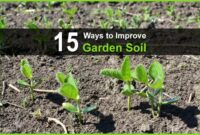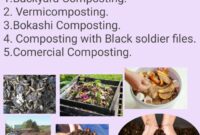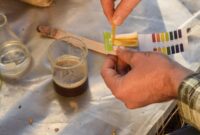Mulching techniques for moisture retention takes center stage in gardening practices, offering an essential guide to preserving soil moisture effectively. Discover the key strategies and benefits of mulching for optimal plant growth and sustainability.
Mulching Materials

When it comes to choosing mulching materials for moisture retention, there are several options available. These materials play a crucial role in preserving soil moisture and promoting plant growth. Let’s explore some of the common mulching materials and their benefits.
Organic Mulches vs. Synthetic Mulches
- Organic Mulches:
- Types: Compost, straw, grass clippings, wood chips, leaves.
- Benefits: Organic mulches decompose over time, adding nutrients to the soil and improving its structure. They also help retain moisture by reducing evaporation and regulating soil temperature.
- Impact on Moisture Retention: Organic mulches are effective at maintaining soil moisture levels, creating a conducive environment for plant roots to absorb water efficiently.
- Synthetic Mulches:
- Types: Plastic, rubber, landscape fabric.
- Benefits: Synthetic mulches are long-lasting and low-maintenance. They can prevent weed growth and conserve moisture by reducing evaporation.
- Impact on Moisture Retention: While synthetic mulches can help conserve moisture, they do not contribute to soil health or nutrient content like organic mulches do.
Mulching Techniques
Mulching techniques play a crucial role in retaining moisture in the soil, helping to keep plants hydrated and healthy. By properly applying mulch and layering it effectively, you can ensure maximum moisture retention for your garden or landscaping needs.
Proper Application of Mulch
When applying mulch for moisture retention, it is important to spread it evenly around the base of plants, leaving a small gap between the mulch and the stem to prevent rot. The layer of mulch should be around 2-4 inches thick to provide adequate coverage and insulation for the soil.
Layering Mulch for Maximum Moisture Retention, Mulching techniques for moisture retention
To maximize moisture retention, consider layering different types of mulch materials. Start with a base layer of coarse mulch, such as wood chips or straw, to allow for air circulation and prevent compaction. Follow this with a layer of finer mulch, like compost or shredded leaves, to help retain moisture and provide nutrients to the soil.
Comparing Mulching Techniques
Different mulching techniques can be used based on the type of plants or soil conditions. For example, organic mulches like straw or bark chips are ideal for vegetable gardens, while inorganic mulches like plastic or gravel may be more suitable for areas with high erosion risks. Consider the specific needs of your plants and soil before choosing the right mulching technique for maximum moisture retention.
Mulching Depth and Frequency

When it comes to mulching for moisture retention, the depth and frequency of mulch application play a crucial role in maximizing the benefits for your garden beds.
To ensure optimal moisture retention, the ideal depth of mulch typically ranges from 2 to 4 inches. This thickness provides enough coverage to prevent evaporation while still allowing air and water to penetrate the soil. However, the depth may vary depending on the type of mulch and the specific needs of your plants.
Ideal Mulching Depth
- For fine mulch materials like compost or shredded leaves, a depth of 2 to 3 inches is usually sufficient.
- Coarser mulches such as wood chips or straw may require a thicker layer of 3 to 4 inches to provide adequate coverage.
Mulch Replenishment Frequency
- It is recommended to replenish mulch once or twice a year to maintain its effectiveness in retaining moisture.
- Check the mulch layer regularly for signs of decomposition or thinning, and add more mulch as needed to ensure consistent coverage.
Adjusting Mulching Depth and Frequency
- During the hot summer months, consider increasing the mulch depth to 4 inches to provide extra insulation and protect plants from heat stress.
- In colder seasons, you may reduce the mulch depth to 2 inches to prevent excessive moisture retention and potential root rot.
- Adjust the frequency of mulch replenishment based on the rate of decomposition and weather conditions in your area to maintain optimal moisture levels.
Mulching Benefits: Mulching Techniques For Moisture Retention

Mulching plays a vital role in reducing evaporation and conserving soil moisture, providing numerous benefits to gardens and landscapes. By creating a barrier between the soil and the atmosphere, mulch helps prevent water loss through evaporation, allowing plants to access moisture more effectively.
Improving Soil Structure and Fertility
Mulching not only helps retain moisture but also contributes to improving soil structure and fertility. As organic mulch materials break down over time, they add valuable nutrients to the soil, enhancing its overall health and productivity. This process promotes the growth of beneficial soil microorganisms and earthworms, further enriching the soil.
Environmental Benefits
Using mulch for moisture retention offers several environmental benefits. By reducing the need for frequent watering, mulching helps conserve water resources, making gardening more sustainable. Additionally, mulch helps prevent soil erosion, suppresses weed growth, and moderates soil temperature, creating a healthier and more stable environment for plants to thrive.
In conclusion, mastering mulching techniques for moisture retention is crucial for maintaining a healthy garden ecosystem. By implementing the right methods, you can enhance soil fertility, reduce water usage, and promote overall plant health. Start mulching today and reap the rewards of a thriving garden!
Are you interested in starting a raised bed garden but not sure where to begin? Check out this guide on how to start raised bed gardening for beginners. Learn the basics of building and maintaining raised beds to grow your own fresh produce.
Curious about the differences between hydroponics and soil gardening? Explore the pros and cons of each method in this informative article comparing hydroponics vs. soil gardening. Discover which technique might be best suited for your gardening needs.
Looking to add some greenery to your space? Get inspired with these creative DIY vertical garden ideas that will transform your walls into living, breathing works of art. From succulents to herbs, there’s a vertical garden idea for everyone.




